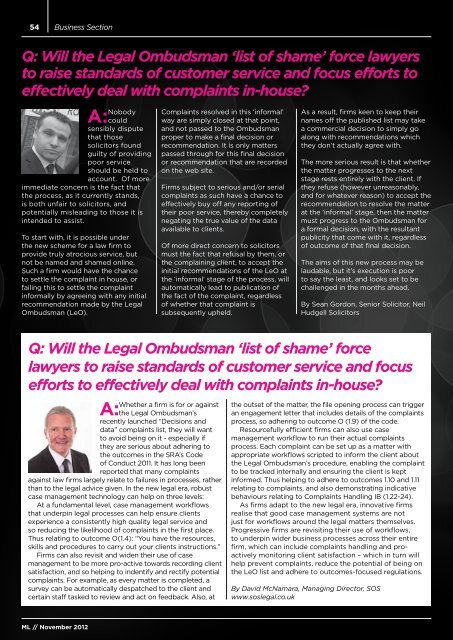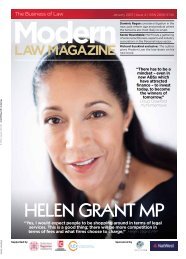Michael Napier
Michael Napier - Modern Law Magazine
Michael Napier - Modern Law Magazine
You also want an ePaper? Increase the reach of your titles
YUMPU automatically turns print PDFs into web optimized ePapers that Google loves.
54Business SectionQ: Will the Legal Ombudsman ‘list of shame’ force lawyersto raise standards of customer service and focus efforts toeffectively deal with complaints in-house?A: Nobodycouldsensibly disputethat thosesolicitors foundguilty of providingpoor serviceshould be held toaccount. Of moreimmediate concern is the fact thatthe process, as it currently stands,is both unfair to solicitors, andpotentially misleading to those it isintended to assist.To start with, it is possible underthe new scheme for a law firm toprovide truly atrocious service, butnot be named and shamed online.Such a firm would have the chanceto settle the complaint in house, orfailing this to settle the complaintinformally by agreeing with any initialrecommendation made by the LegalOmbudsman (LeO).Complaints resolved in this ‘informal’way are simply closed at that point,and not passed to the Ombudsmanproper to make a final decision orrecommendation. It is only matterspassed through for this final decisionor recommendation that are recordedon the web site.Firms subject to serious and/or serialcomplaints as such have a chance toeffectively buy off any reporting oftheir poor service, thereby completelynegating the true value of the dataavailable to clients.Of more direct concern to solicitorsmust the fact that refusal by them, orthe complaining client, to accept theinitial recommendations of the LeO atthe ‘informal’ stage of the process, willautomatically lead to publication ofthe fact of the complaint, regardlessof whether that complaint issubsequently upheld.As a result, firms keen to keep theirnames off the published list may takea commercial decision to simply goalong with recommendations whichthey don’t actually agree with.The more serious result is that whetherthe matter progresses to the nextstage rests entirely with the client. Ifthey refuse (however unreasonably,and for whatever reason) to accept therecommendation to resolve the matterat the ‘informal’ stage, then the mattermust progress to the Ombudsman fora formal decision, with the resultantpublicity that come with it, regardlessof outcome of that final decision.The aims of this new process may belaudable, but it’s execution is poorto say the least, and looks set to bechallenged in the months ahead.By Sean Gordon, Senior Solicitor, NeilHudgell SolicitorsQ: Will the Legal Ombudsman ‘list of shame’ forcelawyers to raise standards of customer service and focusefforts to effectively deal with complaints in-house?Whether a firm is for or againstA: the Legal Ombudsman’srecently launched “Decisions anddata” complaints list, they will wantto avoid being on it - especially ifthey are serious about adhering tothe outcomes in the SRA’s Codeof Conduct 2011. It has long beenreported that many complaintsagainst law firms largely relate to failures in processes, ratherthan to the legal advice given. In the new legal era, robustcase management technology can help on three levels:At a fundamental level, case management workflowsthat underpin legal processes can help ensure clientsexperience a consistently high quality legal service andso reducing the likelihood of complaints in the first place.Thus relating to outcome O(1.4): “You have the resources,skills and procedures to carry out your clients instructions.”Firms can also revisit and widen their use of casemanagement to be more pro-active towards recording clientsatisfaction, and so helping to indentify and rectify potentialcomplaints. For example, as every matter is completed, asurvey can be automatically despatched to the client andcertain staff tasked to review and act on feedback. Also, atthe outset of the matter, the file opening process can triggeran engagement letter that includes details of the complaintsprocess, so adhering to outcome O (1.9) of the code.Resourcefully efficient firms can also use casemanagement workflow to run their actual complaintsprocess. Each complaint can be set up as a matter withappropriate workflows scripted to inform the client aboutthe Legal Ombudsman’s procedure, enabling the complaintto be tracked internally and ensuring the client is keptinformed. Thus helping to adhere to outcomes 1.10 and 1.11relating to complaints, and also demonstrating indicativebehaviours relating to Complaints Handling IB (1.22-24).As firms adapt to the new legal era, innovative firmsrealise that good case management systems are notjust for workflows around the legal matters themselves.Progressive firms are revisiting their use of workflows,to underpin wider business processes across their entirefirm, which can include complaints handling and proactivelymonitoring client satisfaction – which in turn willhelp prevent complaints, reduce the potential of being onthe LeO list and adhere to outcomes-focused regulations.By David McNamara, Managing Director, SOSwww.soslegal.co.ukML // November 2012




